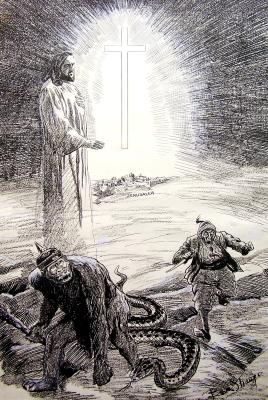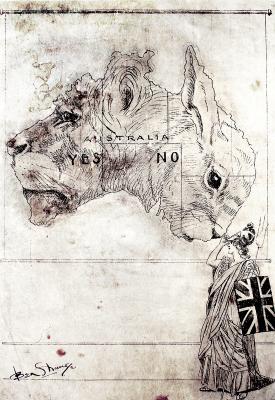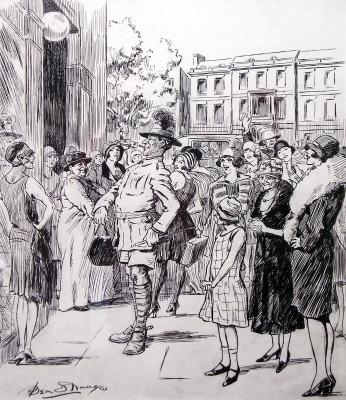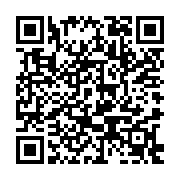CARTOON - STARVATION IN EUROPE
1921Scene of a figure of a woman in long black robes similar to those worn by the figure Death looking over a snow covered landscape in horror. 5 wolves surround the figure and crows are in the background. Human bones can be seen sticking up from the snow. Text on figures robes reads [STARVATION]. Text in the snow in front of the figure reads [EUROPE]
Ben Strange signature bottom left corner
When the cartoon was published on the Western Mail on the 27 October 1921 it featured the caption:
FAMINE - STRICKEN EUROPE
A fund for the relief of sufferers in famine-stricken Europe has been opened by the "West Australian" at the request of a committee, of which the Mayor of Perth (Sir William Lathlain) is the honorary treasurer.
The cartoon presents an image of Europe which is frozen and desolate and where ‘Starvation’, dressed as a terrified figure in rags, is surrounded by images of death and destruction. A pack of wolves follow ‘Starvation’, some of them baying as they run. A crow, another symbol of death, flies through the desolate landscape. Strewn on the frozen ground are human skeletal remains. The overall message is that once again, death and destruction are at play in Europe - help is required. The millions of deaths of the First World War were then followed by the 20-40 million deaths of Spanish flu epidemic, and now starvation bites at the heels of many Europeans.
The cartoon notes that ‘ A fund for the relief of sufferers in famine-affected Europe has been opened by the ‘West Australian’ [newspaper] at the request of a committee of which the Mayor of Perth (Sir William Lathlain) is the honorary treasurer.’
Analysis
While the cartoon suggests that all of Europe is affected by starvation, it was Central Europe, especially Russia, that primarily suffered. During the period 1921 to 1923, it is believed that between 2 and 10 million Russians died of starvation. Drought in some of Russia’s most fertile farming areas, south-western Russia especially, was one factor resulting in famine. However, other factors were World War I, the Bolshevik Revolution and the consequent Civil War which affected farming in the region. Many Russians who had worked the land were now fighting these wars, thereby decreasing the number of workers available to farm. An economic blockade, as a consequence of the 1917 Revolution, meant that agricultural implements and machinery couldn't be brought into the country, again affecting the ability of Russian farmers to return the previously war-ravaged countryside to agricultural prosperity. So, the Russian rural economy was already under pressure, even before the droughts of 1920-21.
Conditions in Russia were so severe that the Soviet Government appealed for assistance from the International community. Various relief programs were established in parts of Europe, Australia and in the USA. Postcards of starving Russian children were sent around the world by concerned agencies. The USA informally agreed to send relief in August of 1920. The US President, Warren Harding, appointed Herbert Hoover, secretary for Commerce at the time, to oversee the relief effort. Congress approved $20 million in aid and hundreds of American volunteers went to Russia to help with the program.
It was the plight of Russian children that especially affected the International community. Images of dead and starving children appalled people and resulted in relief programs such as the one initiated by the
West Australian. By 7 November 1921, £700 6 11 had been raised in this local Appeal. The Western Mail was owned by the same company as the West Australian.
The situation in Russia improved from 1922 onwards, with the Soviet Government introducing their New Economic Policy. By 1926 Russian agriculture was in a far better position than it had been in 1913.
Details
Details
Artist's signature bottom left [Ben Strange]
HIGH
The Ben Strange cartoons are historically significant as they depict many key figures linked to the history and development of both Western Australia and Australia. Political figures who regularly appeared in his cartoon’s included John ‘Happy Jack’ Scaddan, the Premier of Western Australia from 1911 until 1916, and William ‘Billy’ Hughes, the Prime Minister of Australia from 1915 to 1923.
City of Armadale - History House
City of Armadale - History House
Other items by Ben Strange
- CARTOON - CROWD AROUND CAR
- CARTOON - THREE GOLFERS ON A GOLF COURSE
- CARTOON - FINANCIAL RETURN
- CARTOON - THE TRIUMPH OF THE CROSS
- CARTOON - SANTA CLAUSE AND THE SILVER LINK
- CARTOON - THE ROGUE ELEPHANT
- CARTOON - THE GREAT PEACE POSTER
- CARTOON - A LITTLE BABY WITH A BIG BOTTLE
- CARTOON - THE CRUCIFICTION OF REASON
- CARTOON - EAST IS EAST AND WEST IS WEST
- CARTOON - BEAR WITH CAP SITTING ON MAN
- CARTOON - EXCUSE ME I HAVE A DEPUTATION TO MEET
Other items from City of Armadale - History House
- CARTOON - SILENCE IS NOT ALWAYS GOLDEN - AND THE LAW MAKES A POOR CUPID
- CARTOON - WHEN CONSTABULARY DUTYS TO BE DONE - A POLICEMANS LOT IS NOT A HAPPY ONE
- CARTOON - THAT MALIGNANT GROWTH
- CARTOON - THE WATCH DOG
- CARTOON - THE SIMPLE LIFE
- CARTOON - SIR WALTERS NEW MASH
- CARTOON - ADRIFT - DROPPING THE PILOT
- CARTOON - THE LONG TREK FROM THE NORTH
- CARTOON - IN PRAISE OF BEAUTY
- CARTOON - THE STRANGE ADVENTURE OF LITTLE NOT WANTED
- CARTOON - THE DECIDING FACTOR
- CARTOON - ON A GOOD WICKET



